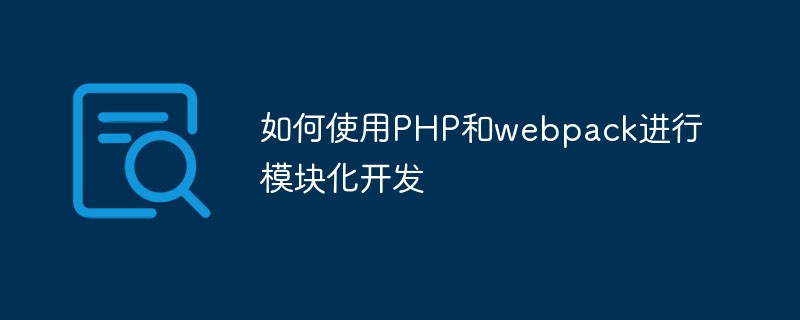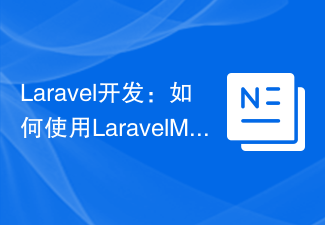
Introduction to Webpack
Webpack is a module packaging tool. It creates modules for different dependencies and packages them all into manageable output files. This is especially useful for single page applications (the de facto standard for web applications today).
Suppose we have an application that can perform two simple mathematical tasks (addition and multiplication). For ease of maintenance, we decide to split these functions into different files.
index.html
<html>
<head>
<script src="src/sum.js"></script>
<script src="src/multiply.js"></script>
<script src="src/index.js"></script>
</head>
</html>index.js
var totalMultiply = multiply(5, 3); var totalSum = sum(5, 3); console.log('Product of 5 and 3 = ' + totalMultiply); console.log('Sum of 5 and 3 = ' + totalSum);
multiply.js
var multiply = function (a, b) {
var total = 0;
for (var i = 0; i < b; i++) {
total = sum(a, total);
}
return total;
};sum.js
var sum = function (a, b) {
return a + b;
};The output of this application should be:
Product of 5 and 3 = 15 Sum of 5 and 3 = 8
How does Webpack help us?
We can't just use tools without knowing what these tools can help us do. So, what has Webpack done for us?
Use modules to rescue dependencies
In the above code, we can see that multiply.js and index.js all depend on sum.js. Therefore, if index.html imports dependencies in the wrong order, our application will not work. For example, if index.js is imported first, or sum.js is imported after multiply.js, you will get an error.
Based on the above example, let us imagine that a real web application may often contain up to dozens of dependencies. There may also be dependencies between these dependencies. Maintaining the relationships between these dependencies The sequence is breathtaking to think about. There may also be a risk of variables being overwritten by other dependencies, which will lead to hard-to-find bugs.
In order to solve this pain point, Webpack will convert dependencies into modules with smaller scopes to avoid variables being overwritten. An added benefit of converting dependencies into modules is that Webpack can manage these dependencies for us. The specific method is that Webpack will introduce dependent modules when needed and match the corresponding scope.
Reduce the number of HTTP requests through packaging
Let’s look back at index.html, in this file we Three separate files need to be downloaded. Of course, the files here are relatively small and can be dealt with, but the problem mentioned before is still there. In a real web application, there may be many dependencies, and this will cause the user to have to wait for all dependencies to be downloaded one by one before the main application can run. .
And this leads to another feature of Webpack - packaging. Webpack can package all dependencies into one file, which means that users only need to download one dependency and the main application can run.
To sum up, the main features of Webpack are Packaging and Modularization. By using plugins and loaders, we can extend these two features of Webpack.
Make the dependencies available and combine them
We will use CommonJS module syntax as an initial setup. Of course, there are other options such as AMD, ES2015, etc., but here we will use CommonJS first and migrate to ES2015 later.
CommonJS exports the module so that other code can use the functions or variables in the exported module. We can read the value in the exported module through require.
index.html
<html>
<head>
<script src="./dist/bundle.js""></script>
</head>
</html>index.js
var multiply = require('./multiply');
var sum = require('./sum');
var totalMultiply = multiply(5, 3);
var totalSum = sum(5, 3);
console.log('Product of 5 and 3 = ' + totalMultiply);
console.log('Sum of 5 and 3 = ' + totalSum);multiply.js
var sum = require('./sum');
var multiply = function (a, b) {
var total = 0;
for (var i = 0; i < b; i++) {
total = sum(a, total);
}
return total;
};
module.exports = multiply;sum.js
var sum = function (a, b) {
return a + b;
};
module.exports = sum;Observing the above code, it is not difficult to find that in order to allow function sum and function multiply to be To use, we exported these two functions in the sum.js and multiply.js scripts. There is a detail here. I don’t know if you have noticed it. In index.html, we only need to import one bundle.js file now.
This is a big help! We now no longer need to worry about the order of dependencies and can expose what we want to expose while keeping the rest private. Also, we now only need to import one file instead of three, which helps the app load faster.
Initial configuration of Webpack
In order to achieve the effect we want to achieve above, we need to do some initial configuration of Webpack.
var path = require('path');
module.exports = {
entry: './src/index.js',
output: {
path: path.resolve(__dirname, './dist/'),
filename: 'bundle.js'
}
}Here we have implemented the simplest configuration. We at least need to tell Webpack where the entry point of our application is and what the output result should be. Let's take a closer look at what each attribute represents.
-
entry: 这个属性表示应用的入口。入口就意味着,这是我们加载程序和程序逻辑的起点。Webpack将从这个入口开始,遍历整棵依赖树。根据遍历结果建立一个依赖间关系图,并创建需要的模块。 -
output.path: 这个属性表示存放打包结果的绝对路径。这里为了方便使用,我们采用了Node.js自带的函数path,这个函数能够根据我们程序所处的位置,动态的创建绝对路径。其中,__dirname是Node.js的一个工具变量,它表示当前文件的目录名。 -
output.filename: 这个属性表示打包结果的文件名。它的名字可以是任意的,只不过我们习惯叫它bundle.js。
来看看bundle.js
阅读生成的bundle.js代码,可以给我们带来一些启发。
// the webpack bootstrap
(function (modules) {
// The module cache
var installedModules = {};
// The require function
function __webpack_require__(moduleId) {
// Check if module is in cache
// Create a new module (and put it into the cache)
// Execute the module function
// Flag the module as loaded
// Return the exports of the module
}
// expose the modules object (__webpack_modules__)
// expose the module cache
// Load entry module and return exports
return __webpack_require__(0);
})
/************************************************************************/
([
// index.js - our application logic
/* 0 */
function (module, exports, __webpack_require__) {
var multiply = __webpack_require__(1);
var sum = __webpack_require__(2);
var totalMultiply = multiply(5, 3);
var totalSum = sum(5, 3);
console.log('Product of 5 and 3 = ' + totalMultiply);
console.log('Sum of 5 and 3 = ' + totalSum);
},
// multiply.js
/* 1 */
function (module, exports, __webpack_require__) {
var sum = __webpack_require__(2);
var multiply = function (a, b) {
var total = 0;
for (var i = 0; i < b; i++) {
total = sum(a, total);
}
return total;
};
module.exports = multiply;
},
// sum.js
/* 2 */
function (module, exports) {
var sum = function (a, b) {
return a + b;
};
module.exports = sum;
}
]);从上面的代码可以看出,Webpack把每一个js脚本都封装到一个模块中,并把这些模块放进数组中。模块数组被传入Webpack的引导程序中,引导程序会把这些模块加入Webpack并执行,使得模块可用。
这里bundle.js返回的是__webpack_require__(0),而这刚好对应了模块数组中的index.js部分。基于此我们同样可以得到正确的运行结果,而不需要处理依赖管理,下载依赖的次数也仅需要一次。
Loader让Webpack更好用
Webpack仅能理解最基本的JavaScript ES5代码,它自身仅支持创建模块并打包JavaScript ES5。如果我们不仅仅局限于JavaScript ES5,例如我们想使用ES2015,这就需要告诉Webpack如何处理ES2015。这里我们的处理方式往往是,我们需要将其它语言(如TypeScript)或其它版本(如ES2015)预处理成JavaScript ES5,再让Webpack做打包。这里就需要使用Babel来做转换,把ES2015转换为ES5(当然Babel能做的事情远不止如此)。
为了说明这个过程,我们使用ES2015重写之前的功能。
index.js
import multiply from './multiply';
import sum from './sum';
const totalMultiply = multiply(5, 3);
const totalSum = sum(5, 3);
console.log(`Product of 5 and 3 = ${totalMultiply}`);
console.log(`Sum of 5 and 3 = ${totalSum}`);multiply.js
import sum from './sum';
const multiply = (a, b) => {
let total = 0;
for(let i=0;i<b;i++) {
total = sum(a, total);
}
return total;
};
export default multiply;sum.js
const sum = (a, b) => a + b; export default sum;
这里我们使用了很多ES2015的新特性,例如箭头函数、const关键字、模板字符串和ES2015的导入导出。ES2015的代码Webpack无法处理,所以我们需要Babel来进行转换。想要让Babel配合Webpack完成工作,我们就需要用到Babel Loader。事实上,Loader就是Webpack处理JavaScript ES5以外内容的方式。有了加载器,我们就可以让Webpack处理各式各样的文件。
想要在Webpack中使用Babel Loader,我们还需要三个Babel依赖:
babel-loader: 提供Babel与Webpack之间的接口;babel-core: 提供读取和解析代码的功能,并生成对应的输出;babel-preset-es2015: 提供将ES2015转换为ES5的Babel规则;
在Webpack中配置Babel Loader的代码,差不多是下面这样子:
const path = require('path');
module.exports = {
entry: './src/index.js',
output: {
path: path.resolve(__dirname, './dist/'),
filename: 'bundle.js'
},
module: {
loaders: [
{
test: /.js$/,
loader: 'babel-loader',
exclude: /node_modules/,
query: {
presets: ['es2015']
}
}
]
}
};这段代码你可以在webpack.config.js中找到。值得注意的是,Webpack中是支持同时存在多个Loader的,所以提供的值是一个数组。接着,还是让我们来看看每个属性代表的含义。
-
test: 我们只希望Loader处理JavaScript文件,这里通过一个正则表达式匹配.js文件; -
loader: 要使用的Loader,这里使用了babel-loader; -
exclude: 哪些文件不需要被处理,这里我们不希望Babel处理node_modules下的任何文件; -
query.presets: 我们需要使用哪个规则,这里我们使用Babel转换ES2015的规则;
配置好这些内容后,再次查看打包生成的bundle.js,其中的内容看起来就像下面这样:
/* 2 */
function(module, exports) {
var sum = function sum(a, b) {
return a + b;
};
module.exports = sum;
}可以看到,Babel Loader已经把ES2015的代码变成了ES5的代码。
CSS与样式,让Webpack看起来更出色
接下来,让我们拓展上面的例子,输出计算结果。我们将在页面上创建一个body,然后把乘积与加和的结果添加到span中。
import multiply from './multiply';
import sum from './sum';
const totalMultiply = multiply(5, 3);
const totalSum = sum(5, 3);
// create the body
const body = document.createElement("body");
document.documentElement.appendChild(body);
// calculate the product and add it to a span
const multiplyResultsSpan = document.createElement('span');
multiplyResultsSpan.appendChild(document.createTextNode(`Product of 5 and 3 = ${totalMultiply}`));
// calculate the sum and add it to a span
const sumResultSpan = document.createElement('span');
sumResultSpan.appendChild(document.createTextNode(`Sum of 5 and 3 = ${totalSum}`));
// add the results to the page
document.body.appendChild(multiplyResultsSpan);
document.body.appendChild(sumResultSpan);这段代码的输出结果,应该与之前是一致的,区别仅在于显示在页面上。
Product of 5 and 3 = 15 Sum of 5 and 3 = 8
我们可以使用CSS来美化这个结果,比如,我们可以让每个结果都独占一行,并且给每个结果都加上边框。为了实现这一点,我们可以使用如下的CSS代码。
span {
border: 5px solid brown;
display: block;
}我们需要将这个CSS也导入应用中。这里最简单的解决方案是,在我们的html中添加一个link标签。但有了Webpack提供的强大功能,我们可以先导入它,再用Webpack来处理这个样式。
在代码中导入CSS带来的另一个好处是,开发者可以清晰的看到CSS与其使用之间的关联。这里需要注意的是,CSS的作用域并不局限于它所导入的模块本身,其作用域仍然是全局的,但从开发者的角度看,这样使用更加清晰。
import multiply from './multiply';
import sum from './sum';
// import the CSS we want to use here
import './math_output.css';
const totalMultiply = multiply(5, 3);
const totalSum = sum(5, 3);
// create the body
const body = document.createElement("body");
document.documentElement.appendChild(body);
// calculate the product and add it to a span
const multiplyResultsSpan = document.createElement('span');
multiplyResultsSpan.appendChild(document.createTextNode(`Product of 5 and 3 = ${totalMultiply}`));
// calculate the sum and add it to a span
const sumResultSpan = document.createElement('span');
sumResultSpan.appendChild(document.createTextNode(`Sum of 5 and 3 = ${totalSum}`));
// add the results to the page
document.body.appendChild(multiplyResultsSpan);
document.body.appendChild(sumResultSpan);这段代码中,与前面代码的唯一区别在于,我们导入了CSS。我们需要两个Loader来处理我们的CSS:
css-loader: 用于处理CSS导入,具体来说,获取导入的CSS并加载CSS文件内容;style-loader: 获取CSS数据,并添加它们到HTML文档中;
现在我们在webpack.config.js中的Webpack配置看起来像这样:
const path = require('path');
module.exports = {
entry: './src/index.js',
output: {
path: path.resolve(__dirname, './dist/'),
filename: 'bundle.js'
},
module: {
loaders: [
{
test: /.js$/,
loader: 'babel-loader',
exclude: /node_modules/,
query: {
presets: ['es2015']
}
},
{
test: /.css$/,
loaders: ['style-loader', 'css-loader']
}
]
}
};我们还是来看看新增的CSS配置属性所表示的内容。
-
test: 我们需要告诉Loader,我们只需要它处理CSS文件。这里的正则表达式仅匹配CSS文件。 -
loaders: 这里与前面不同的是,我们使用了多个Loader。还有一个需要注意的细节是,Webpack从右向左处理loader,因此css-loader处理的结果(读出CSS文件内容)会被传递给style-loader,最终得到的是style-loader的处理结果(将样式添加到HTML文档中)。
假如我们现在需要提取CSS,并输出到一个文件中,再导入该文件。为了实现这一点,我们就要用到Plugin。Loader的作用在于,在数据被打包输出前进行预处理。而Plugin则可以阻止预处理的内容直接出现在我们的打包结果中。
我们的Webpack配置现在变成了这样:
const path = require('path');
const ExtractTextPlugin = require('extract-text-webpack-plugin');
module.exports = {
entry: './src/index.js',
output: {
path: path.resolve(__dirname, './dist/'),
filename: 'bundle.js'
},
module: {
loaders: [
{
test: /.js$/,
loader: 'babel-loader',
exclude: /node_modules/,
query: {
presets: ['es2015']
}
},
{
test: /.css$/,
loader: ExtractTextPlugin.extract('css-loader')
}
]
},
plugins: [
new ExtractTextPlugin('style.css')
]
};在这段代码的顶部,我们导入了ExtractTextPlugin,并使用这个插件改造了之前的CSS Loader。这里的作用是,css-loader的处理结果不再直接返回给Webpack,而是传递给ExtractTextPlugin。在底部我们配置了这个Plugin。
这里配置的作用是,对于传递给ExtractTextPlugin的CSS样式数据,将会被保存在名为style.css的文件中。这样做的好处与之前处理JavaScript时一样,我们可以将多个独立的CSS文件合并为一个文件,从而减少加载样式时的下载次数。
最终我们可以直接使用我们合并好的CSS,实现和之前一致的效果。
<html>
<head>
<link rel="stylesheet" href="dist/style.css"/>
<script src="./dist/bundle.js""></script>
</head>
</html>使用Webpack处理图片
现在我们开始尝试向应用中添加图片,并让Webpack来协助我们处理这些图片。这里我们添加了两张图片,一个用于求和,一个用于求积。为了让Webpack有能力处理这些图片,我们使用这两个Loader:
image-webpack-loader: 尝试帮助我们自动压缩图片体积;url-loader: 如果image-webpack-loader的输出图片体积小,就内联使用这些图片,如果image-webpack-loader的输出图片体积大,就将图像包含在输出目录中;
我们准备了两张图片,用于求积的图片(multiply.png)相对较大,用于求和的图片(sum.png)相对较小。首先,我们添加一个图片工具方法,这个方法会为我们创建图片,并将图片添加到文档中。
image_util.js
const addImageToPage = (imageSrc) => {
const image = document.createElement('img');
image.src = imageSrc;
image.style.height = '100px';
image.style.width = '100px';
document.body.appendChild(image);
};
export default addImageToPage;接着,让我们导入这个图片工具方法,以及我们想要添加到index.js中的图片。
import multiply from './multiply';
import sum from './sum';
// import our image utility
import addImageToPage from './image_util';
// import the images we want to use
import multiplyImg from '../images/multiply.png';
import sumImg from '../images/sum.png';
// import the CSS we want to use here
import './math_output.css';
const totalMultiply = multiply(5, 3);
const totalSum = sum(5, 3);
// create the body
const body = document.createElement("body");
document.documentElement.appendChild(body);
// calculate the product and add it to a span
const multiplyResultsSpan = document.createElement('span');
multiplyResultsSpan.appendChild(document.createTextNode(`Product of 5 and 3 = ${totalMultiply}`));
// calculate the sum and add it to a span
const sumResultSpan = document.createElement('span');
sumResultSpan.appendChild(document.createTextNode(`Sum of 5 and 3 = ${totalSum}`));
// add the results to the page
addImageToPage(multiplyImg);
document.body.appendChild(multiplyResultsSpan);
addImageToPage(sumImg);
document.body.appendChild(sumResultSpan);最后,我们还是来修改webpack.config.js,配置两个新的Loader来处理这些图片。
const path = require('path');
const ExtractTextPlugin = require('extract-text-webpack-plugin');
module.exports = {
entry: './src/index.js',
output: {
path: path.resolve(__dirname, './dist/'),
filename: 'bundle.js',
publicPath: 'dist/'
},
module: {
loaders: [
{
test: /.js$/,
loader: 'babel-loader',
exclude: /node_modules/,
query: {
presets: ['es2015']
}
},
{
test: /.css$/,
loader: ExtractTextPlugin.extract('css-loader')
},
{
test: /.png$/,
loaders: [
'url-loader?limit=5000',
'image-webpack-loader'
]
}
]
},
plugins: [
new ExtractTextPlugin('style.css')
]
};还是老规矩,我们来看看新增的参数都表示什么含义。
-
output.publicPath: 让url-loader知道,保存到磁盘的文件需要添加指定的前缀。例如,我们需要保存一个output_file.png,那么最终保存的路径应该是dist/output_file.png; -
test: 还是和之前一样,通过正则表达式匹配图像文件,非图像文件不处理; -
loaders: 这里还是要再强调一下,Webpack从右向左处理loader,因此image-webpack-loader的处理结果将会被传递给url-loader继续处理。
现在我们执行Webpack打包,会得到下面三个东西。
38ba485a2e2306d9ad96d479e36d2e7b.png bundle.js style.css
这里的38ba485a2e2306d9ad96d479e36d2e7b.png实际上就是我们的大图片multiply.png,较小的图片sum.png会被内联到bundle.js中,就像下面这样。
module.exports = "data:image/png;base64,iVBORw0KGgoAAAANSUhEUgAAAoAAAAHgCAMAAAACDyzWAAAC6FBMVEUAuv8AgL...."
这其实相当于
img.src="data:image/png;base64,iVBORw0KGgoAAAANSUhEUgAAAoAAAAHgCAMAAAACDyzWAAAC6FBMVEUAuv8AgL..."
更多编程相关知识,请访问:编程视频!!
The above is the detailed content of What is Webpack? Detailed explanation of how it works?. For more information, please follow other related articles on the PHP Chinese website!
 VUE3入门教程:使用Webpack进行打包和构建Jun 15, 2023 pm 06:17 PM
VUE3入门教程:使用Webpack进行打包和构建Jun 15, 2023 pm 06:17 PMVue是一款优秀的JavaScript框架,它可以帮助我们快速构建交互性强、高效性好的Web应用程序。Vue3是Vue的最新版本,它引入了很多新的特性和功能。Webpack是目前最流行的JavaScript模块打包器和构建工具之一,它可以帮助我们管理项目中的各种资源。本文就为大家介绍如何使用Webpack打包和构建Vue3应用程序。1.安装Webpack
 vite和webpack的区别是什么Jan 11, 2023 pm 02:55 PM
vite和webpack的区别是什么Jan 11, 2023 pm 02:55 PM区别:1、webpack服务器启动速度比vite慢;由于vite启动的时候不需要打包,也就无需分析模块依赖、编译,所以启动速度非常快。2、vite热更新比webpack快;vite在HRM方面,当某个模块内容改变时,让浏览器去重新请求该模块即可。3、vite用esbuild预构建依赖,而webpack基于node。4、vite的生态不及webpack,加载器、插件不够丰富。
 如何使用PHP和webpack进行模块化开发May 11, 2023 pm 03:52 PM
如何使用PHP和webpack进行模块化开发May 11, 2023 pm 03:52 PM随着Web开发技术的不断发展,前后端分离、模块化开发已经成为了一个广泛的趋势。PHP作为一种常用的后端语言,在进行模块化开发时,我们需要借助一些工具来实现模块的管理和打包,其中webpack是一个非常好用的模块化打包工具。本文将介绍如何使用PHP和webpack进行模块化开发。一、什么是模块化开发模块化开发是指将程序分解成不同的独立模块,每个模块都有自己的作
 vue webpack可打包哪些文件Dec 20, 2022 pm 07:44 PM
vue webpack可打包哪些文件Dec 20, 2022 pm 07:44 PM在vue中,webpack可以将js、css、图片、json等文件打包为合适的格式,以供浏览器使用;在webpack中js、css、图片、json等文件类型都可以被当做模块来使用。webpack中各种模块资源可打包合并成一个或多个包,并且在打包的过程中,可以对资源进行处理,如压缩图片、将scss转成css、将ES6语法转成ES5等可以被html识别的文件类型。
 Webpack是什么?详解它是如何工作的?Oct 13, 2022 pm 07:36 PM
Webpack是什么?详解它是如何工作的?Oct 13, 2022 pm 07:36 PMWebpack是一款模块打包工具。它为不同的依赖创建模块,将其整体打包成可管理的输出文件。这一点对于单页面应用(如今Web应用的事实标准)来说特别有用。
 webpack怎么将es6转成es5的模块Oct 18, 2022 pm 03:48 PM
webpack怎么将es6转成es5的模块Oct 18, 2022 pm 03:48 PM配置方法:1、用导入的方法把ES6代码放到打包的js代码文件中;2、利用npm工具安装babel-loader工具,语法“npm install -D babel-loader @babel/core @babel/preset-env”;3、创建babel工具的配置文件“.babelrc”并设定转码规则;4、在webpack.config.js文件中配置打包规则即可。
 使用Spring Boot和Webpack构建前端工程和插件系统Jun 22, 2023 am 09:13 AM
使用Spring Boot和Webpack构建前端工程和插件系统Jun 22, 2023 am 09:13 AM随着现代Web应用程序的复杂性不断增加,构建优秀的前端工程和插件系统变得越来越重要。随着SpringBoot和Webpack的流行,它们成为了一个构建前端工程和插件系统的完美组合。SpringBoot是一个Java框架,它以最小的配置要求来创建Java应用程序。它提供了很多有用的功能,比如自动配置,使开发人员可以更快、更容易地搭建和部署Web应用程序。W
 Laravel开发:如何使用Laravel Mix和Webpack优化文件大小?Jun 13, 2023 pm 04:44 PM
Laravel开发:如何使用Laravel Mix和Webpack优化文件大小?Jun 13, 2023 pm 04:44 PMLaravel开发:如何使用LaravelMix和Webpack优化文件大小?Laravel是一个非常流行的PHP框架,它提供了许多功能和工具,帮助开发者在构建Web应用程序时提高生产效率。其中,LaravelMix和Webpack是两个强大的工具,它们可以帮助您优化文件大小和提高性能。在本文中,我们将介绍如何使用LaravelMix和Webpack优


Hot AI Tools

Undresser.AI Undress
AI-powered app for creating realistic nude photos

AI Clothes Remover
Online AI tool for removing clothes from photos.

Undress AI Tool
Undress images for free

Clothoff.io
AI clothes remover

AI Hentai Generator
Generate AI Hentai for free.

Hot Article

Hot Tools

Dreamweaver CS6
Visual web development tools

SecLists
SecLists is the ultimate security tester's companion. It is a collection of various types of lists that are frequently used during security assessments, all in one place. SecLists helps make security testing more efficient and productive by conveniently providing all the lists a security tester might need. List types include usernames, passwords, URLs, fuzzing payloads, sensitive data patterns, web shells, and more. The tester can simply pull this repository onto a new test machine and he will have access to every type of list he needs.

MantisBT
Mantis is an easy-to-deploy web-based defect tracking tool designed to aid in product defect tracking. It requires PHP, MySQL and a web server. Check out our demo and hosting services.

mPDF
mPDF is a PHP library that can generate PDF files from UTF-8 encoded HTML. The original author, Ian Back, wrote mPDF to output PDF files "on the fly" from his website and handle different languages. It is slower than original scripts like HTML2FPDF and produces larger files when using Unicode fonts, but supports CSS styles etc. and has a lot of enhancements. Supports almost all languages, including RTL (Arabic and Hebrew) and CJK (Chinese, Japanese and Korean). Supports nested block-level elements (such as P, DIV),

ZendStudio 13.5.1 Mac
Powerful PHP integrated development environment







